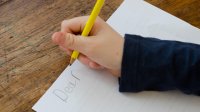3 Authentic Multimodal Projects for Young Writers
Second-grade students can find deeper engagement in writing when they know their work has an audience beyond the teacher.
Your content has been saved!
Go to My Saved Content.My co-teacher often says, “We cannot start to teach them until they are in the room.” I interpret this to mean that if my students are not present and engaged during instruction, nothing I can do will help them learn. The saying took on new meaning for me this year, because my second-grade class had a challenge: writing time. Instead of writing being a joyful time for self-expression and sharing, it was turning into a time of big behaviors and classroom management challenges. This prompted me to ask: What could I do to get my second graders back in the room during writing?
I started doing research into student engagement during writing, which helped me appreciate the power of multimodal writing choices. The definition of what we consider to be writing is rapidly evolving as advances in technology make it possible for even our youngest learners to use video, mix text with audio, and even write code to share their thinking. Kids are more engaged when they know that they have real-life reasons for writing and when they can choose the modality that works for them. This year, I came up with ways to make these strategies work for my young learners.
3 Multimodal Ideas
1. Put them to work. The co-construction of essential materials for the classroom is a straightforward way to lend authentic purpose to student work. To do this, I recruited my class to make something that we genuinely needed: a substitute binder.
They each wrote a paragraph explaining what they thought the guest teacher should know about how they learned and the way our classroom functioned. Using the format of a shared PowerPoint, I took a picture of their physical writing and added an embedded video of the student reading their paragraph. My second graders rechecked their work to make revisions so that their writing would be understandable and useful to the substitute.
The urgency and importance that the students felt when they were writing about how their classroom should be run came through in the quantity and quality of their work. They knew that their work would be tested on my first day out of the classroom with a guest teacher. It turned out to be one of my easiest sub days ever!
2. Go national (or even global). Another powerful way to add authentic purpose to student work is to collaborate with classrooms around the country or even the world. This year we participated in a national postcard exchange to integrate writing with our study of geography. For this project, we used digital tools for the planning stage of writing. Using Seesaw, my students made voice recordings, sketches, and videos sharing what they knew about their favorite local land forms and why they were important to our community. This Seesaw activity served as an oral rehearsal, helping them to write postcards about the geography and culture of where we live.
They were motivated and excited by the fact that second-grade peers from other states would be reading their work. You can find other classrooms to collaborate with by joining Postcard Exchange groups on Facebook or Twitter or investigating established collaboration platforms such as PenPal Schools or iEARN.
3. Write outside the box. Finally, it can be useful to allow as much choice as possible during writing. As a class, we brainstormed a list of things that they could do to share their learning with others. I was able to leverage students’ preferred modes of expression by having them create a digital museum about how our community has changed over time. They chose the modality that best fit what they wanted to present.
As long as their project included the necessary elements from our rubric (a title, dates, expert words), they were free to choose the format. Some created posters, some wrote books, and one group even created a Lego model of a 19th-century lumber mill.
In addition, each group had to write a script that they would use to explain their project. I recruited parent volunteers to help my students make videos of their informational writing projects to share their learning about local history. After displaying and sharing our projects in an in-class museum, we used ThingLink to make the video presentations shareable to families and to our local history museum.
The Impact of Multimodal Writing
In each of these examples, I noticed positive shifts in the level of focus and engagement that my students showed during writing. My students knew that they were writing for a reason. They were more willing to tolerate frustration and see their work through to the end. They were also motivated to go back to revise to make their writing better.
Second graders love being useful to others. They knew that their work needed to be understandable in order to be helpful. They felt a sense of pride and accomplishment when their writing helped a guest teacher to follow our class routines. They knew that they were contributing something important to other second graders’ understanding of our country with their postcards about our local geography. And when they presented their museum projects, they took on the role of curators, choosing what they felt was important for their families and peers about our local history.
I also learned very quickly that I could not predict the outcome or impact that their work would have on others. It was necessary to let go of control, but it was worth it. This experiment has had the effect of increasing not only my students’ engagement but mine as well. This process has helped me to understand that the goal is less about getting students in the room with me and more about joining my students to view writing as an adventure that we embark on together.
